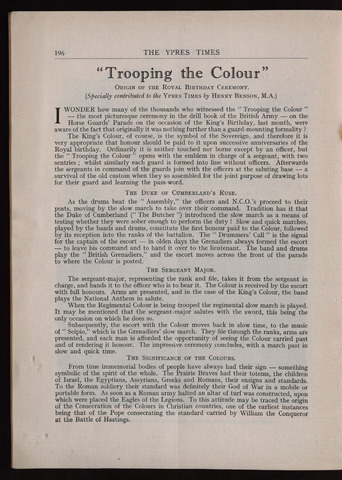"Trooping the Colour"
196
THE YPRES TIMES
Origin of the Royal Birthday Ceremony.
[Specially contributed, to the Ypres Times by Henry Benson, M.A.)
I WONDER how many of the thousands who witnessed the Trooping the Colour
the most picturesque ceremony in the drill book of the British Army on the
Horse Guards' Parade on the occasion of the King's Birthday, last month, were
aware of the fact that originally it was nothing further than a guard-mounting formality
The King's Colour, of course, is the symbol of the Sovereign, and therefore it is
very appropriate that honour should be paid to it upon successive anniversaries of the
Royal birthday. Ordinarily it is neither touched nor borne except by an officer, but
the Trooping the Colour opens with the emblem in charge of a sergeant, with two
sentries whilst similarly each guard is formed into line without officers. Afterwards
the sergeants in command of the guards join with the officers at the saluting base a
survival of the old custom when they so assembled for the joint purpose of drawing lots
for their guard and learning the pass-word.
The Duke of Cumberland's Ruse.
As the drums beat the Assembly," the officers and N.C.O.'s proceed to their
posts, moving by the slow march to take over their command. Tradition has it that
the Duke of Cumberland The Butcher introduced the slow march as a means of
testing whether they were sober enough to perform the duty Slow and quick marches,
played by the bands and drums, constitute the first honour paid to the Colour, followed
by its reception into the ranks of the battalion. The Drummers' Call is the signal
for the captain of the escort in olden days the Grenadiers always formed the escort
to leave his command and to hand it over to the lieutenant. The band and drums
play the British Grenadiers," and the escort moves across the front of the parade
to where the Colour is posted.
The Sergeant Major.
The sergeant-major, representing the rank and file, takes it from the sergeant in
charge, and hands it to the officer who is to bear it. The Colour is received by the escort
with full honours. Arms are presented, and in the case of the King's Colour, the band
plays the National Anthem in salute.
When the Regimental Colour is being trooped the regimental slow march is played.
It may be mentioned that the sergeant-major salutes with the sword, this being the
only occasion on which he does so.
Subsequently, the escort with the Colour moves back in slow time, to the music
of Scipio," which is the Grenadiers' slow march. They file through the ranks, arms are
presented, and each man is afforded the opportunity of seeing the Colour carried past
and of rendering it honour. The impressive ceremony concludes, with a march past in
slow and quick time.
The Significance of the Colours.
From time immemorial bodies of people have always had their sign something
symbolic of the spirit of the whole. The Prairie Braves had their totems, the children
of Israel, the Egyptians, Assyrians, Greeks and Romans, their ensigns and standards.
To the Roman soldiery their standard was definitely their God of War in a mobile or
portable form. As soon as a Roman army halted an altar of turf was constructed, upon
which were placed the Eagles of the Legions. To this attitude may be traced the origin
of the Consecration of the Colours in Christian countries, one of the earliest instances
being that of the Pope consecrating the standard carried by William the Conqueror
at the Battle of Hastings.

